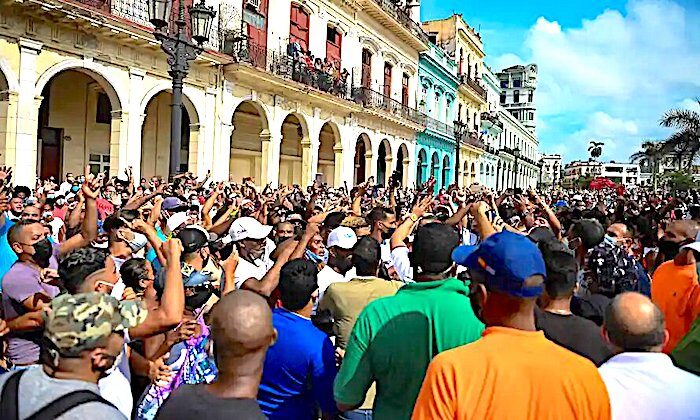
The protests began in the morning, in the town of San Antonio de los Baños in the west of the island, and in the city of Palma Soriano in the east. In both cases protesters numbered in the hundreds.
With millions of Cubans now with mobile internet on their phones, news of the protests quickly swept to Havana. By early afternoon, thousands marched through central Havana, chanting "homeland and life" and "freedom".
"I'm here because of hunger, because there's no medicine, because of power cuts - because there's a lack of everything," said a man in his 40s who didn't want to give his name for fear of reprisals. "I want a total change: a change of government, multiparty elections, and the end of communism."
The protesters were met by uniformed and plainclothes police officers, who bundled hundreds of demonstrators - many of them violent - into police cars. Youths tore up paving slabs and hurled them at police; police used pepper spray and beat protesters with truncheons.
One policeman, hit on the head with a cobblestone, was sped away in a car that nearly ran over a protester.
With a rock in each hand, Yusniel Pérez, 17, said: "We're here because we're hungry and poor. We don't have food. We don't have anything."
At 3pm local time all television channels were interrupted with a broadcast from President Miguel Díaz-Canel who said that "destabilisation in our country" would be met with a "revolutionary response."
"We call upon all the revolutionaries of the country, all the communists, to take to the streets."
A game of cat and mouse ensued, where young anti-government protesters tried to occupy iconic parts of the capital, only to be blocked off by older government supporters, state security and the army.
Aylin Guerrero, 52, was one of thousands who came out to support the government, in central Havana. Surrounded by thousands of government supporters some bearing wooden clubs, she said: "We are the people and we have come out to support our conquests. Even if we're not communists, we're patriots."
Government supporters accused anti-government protesters of being mercenaries paid by the United States, which spends approximately 20 million dollars a year on "democracy promotion" on the island.
As evening fell, state forces and supporters had reclaimed the streets.
The protests were concentrated in Havana's more impoverished municipalities. The underlying grievance of those interviewed was longstanding scarcity and privation. Cubans are living through the gravest economic crisis the country has known for 30 years. The Trump administration hammered the island with more than 200 new sanctions aimed at sabotaging the island's' economy and stirring discontent, measures that have so far been left untouched by the Biden administration.
Since the pandemic, which has gutted tourism revenue, Cubans have become accustomed to waiting in line for hours to buy basic goods like chicken and detergent. Pharmacy shelves are barren.
The protests were the biggest since 1994, when tens of thousands demonstrated at Havana's Malecón promenade amid an acute economic crisis brought on by the fall of the Soviet Union.
An official in the Biden administration tweeted support for Sunday's demonstrations. Julie Chung, acting assistant secretary of state for western hemisphere affairs, tweeted:
"Peaceful protests are growing in Cuba as the Cuban people exercise their right to peaceful assembly to express concern about rising Covid cases/deaths & medicine shortages. We commend the numerous efforts of the Cuban people mobilizing donations to help neighbors in need."



Comment: An already festering unrest in Cuba is compounded by US intervention via sanctions and protest propaganda: